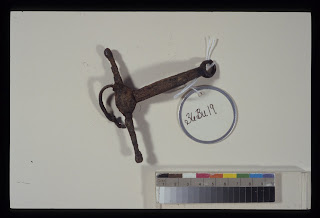Archaeology is the study of past human behavior. One way archaeologists study the past is by examining locations where people worked, played and lived. These are called archaeological sites. They can consist of a few pieces of chipped stone and a broken spear point (the prehistoric equivalent of a modern deer stand) or thousands of artifacts with hearths, storage pits and burials. Large or small all sites contain information about the past. Some are more important than others but they are all part of the story about life in the past. They are like pieces of a puzzle. Unfortunately, sites are destroyed everyday by modern development and urban sprawl and pieces of the puzzle are lost forever. Archaeological sites are non-renewable resources and once lost, the knowledge they contain will never be recovered.
The Pennsylvania Historical and Museum Commission (PHMC) maintains a record of archaeological sites in the Commonwealth called the Pennsylvania Archaeological Site Survey (PASS) files. This is organized into a geographic information system based format. The information is used for research purposes but also to assist state and federal agencies in the management of sites that may be affected by their construction projects. Sites can be protected if they are recorded in the PASS files. The PASS files were first generated and are maintained by a group of committed individuals who enjoy the excitement of finding treasures from the past, but more importantly, are dedicated to the concept that archaeological sites are significant scientific laboratories that are essential to our understanding of the past (and managing our future).
The PHMC has been systematically recording site locations since the 1950s. Until the files were consolidated in the 1980s, the Carnegie Museum assisted in the site recording process for the western most 17 counties. Much of the information has been submitted by members of the Society for Pennsylvania Archaeology, Inc and other amateur archaeologists but also interested landowners and state and federal agencies. The PASS files currently contain information on over 22,000 historic and prehistoric sites. This information has made a significant contribution to archaeological research and the protection and preservation of the Commonwealth’s archaeological heritage.
In addition to those who are interested in the scientific data, many people collect artifacts, both from the historic and prehistoric periods, as a hobby. They simply enjoy collecting and displaying artifacts. When the farm fields are freshly plowed in the spring many hobbyists are excited about getting out and collecting” arrowheads” from their favorite fields. We frequently hear stories from people about their collection of spear points that they have accumulated over the years. With fond memories they recount the hours they spent with a father or friend collecting arrowheads. However, excessive surface collecting is slowing eroding the database of our past.
Hobbyists, also, frequently trade, buy and sell artifacts. All too often, important excavation data is not included with the transfer of the artifact and unfortunately another piece of the puzzle will be lost from the scientific record. The archaeological community (both the professionals and the amateurs) have tolerated this type of activity because these hobbyists occassionally share their site locations and a small percentage of this data gets recorded. However, in the long run, the hobbyists who do not record this data with the PASS files, are doing more harm than good.
Unfortunately, in recent years, it has become increasingly common for hobbyists to dig for artifacts. Scientific archaeological excavation focuses on the three dimensional mapping of artifacts and features within natural soil horizons. It is a complicated process. An archaeological excavation is a destructive process and it is necessary to collect as much data as possible to reconstruct the natural and cultural environment under which the artifacts were deposited. It can not be learned in a weekend or even in a summer. To understand and appreciate all of the intricacies of how to excavate a site requires years of training.
The individuals who dig up artifacts are not systematically recording all the necessary information to evaluate the context. The artifacts they recover are practically worthless as scientific data. Digging for artifacts is simply looting. Even worse is the looting of artifacts on public land. This is stealing from the citizens of the Commonwealth. Under the State History Code, it is punishable by fines, imprisonment and the confiscation of all artifacts and equipment. For all citizens, the theft of our heritage can not be condoned.
We understand the excitement of finding artifacts. We urge everyone with information about sites to record site locations and artifacts with the Pennsylvania Archaeological Site Survey (PASS) files. Our web site contains information and forms on how you can begin to protect the archaeological data base of our past








